steering Hyundai Equus 2016 Owner's Manual
[x] Cancel search | Manufacturer: HYUNDAI, Model Year: 2016, Model line: Equus, Model: Hyundai Equus 2016Pages: 477, PDF Size: 16.25 MB
Page 15 of 477
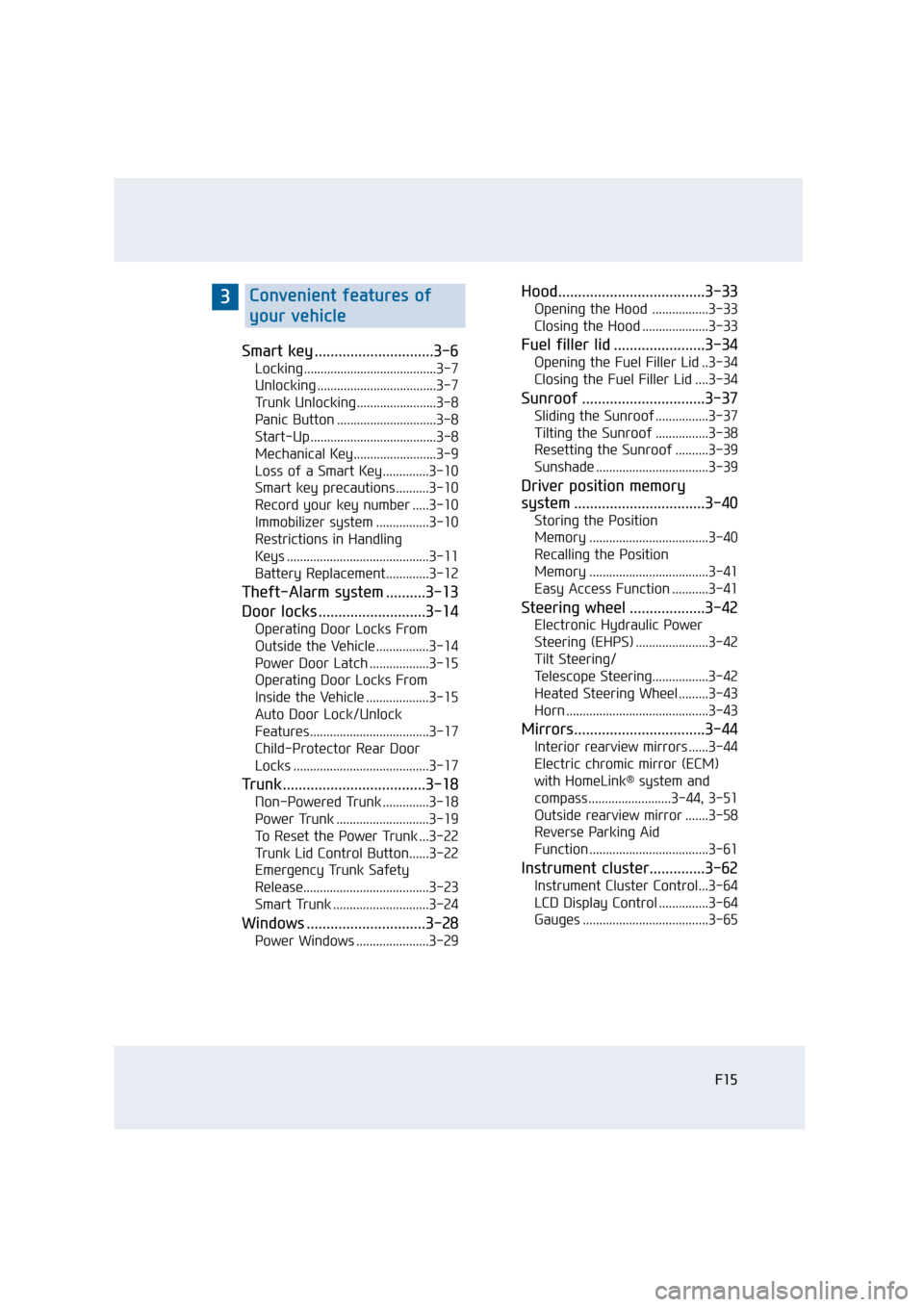
Smart key ..............................3-6
Locking ........................................3-7
Unlocking ....................................3-7
Trunk Unlocking ........................3-8
Panic Button ..............................3-8
Start-Up ......................................3-8
Mechanical Key.........................3-9
Loss of a Smart Key..............3-10
Smart key precautions..........3-10
Record your key number .....3-10
Immobilizer system ................3-10
Restrictions in Handling
Keys ...........................................3-11
Battery Replacement.............3-12
Theft-Alarm system ..........3-13
Door locks ...........................3-14
Operating Door Locks From
Outside the Vehicle ................3-14
Power Door Latch ..................3-15
Operating Door Locks From
Inside the Vehicle ...................3-15
Auto Door Lock/Unlock
Features....................................3-17
Child-Protector Rear Door
Locks .........................................3-17
Trunk....................................3-18
Non-Powered Trunk ..............3-18
Power Trunk ............................3-19
To Reset the Power Trunk ...3-22
Trunk Lid Control Button......3-22
Emergency Trunk Safety
Release......................................3-23
Smart Trunk .............................3-24
Windows ..............................3-28
Power Windows ......................3-29
Hood.....................................3-33
Opening the Hood .................3-33
Closing the Hood ....................3-33
Fuel filler lid .......................3-34
Opening the Fuel Filler Lid ..3-34
Closing the Fuel Filler Lid ....3-34
Sunroof ...............................3-37
Sliding the Sunroof ................3-37
Tilting the Sunroof ................3-38
Resetting the Sunroof ..........3-39
Sunshade ..................................3-39
Driver position memory
system .................................3-40
Storing the Position
Memory ....................................3-40
Recalling the Position
Memory ....................................3-41
Easy Access Function ...........3-41
Steering wheel ...................3-42
Electronic Hydraulic Power
Steering (EHPS) ......................3-42
Tilt Steering/
Telescope Steering.................3-42
Heated Steering Wheel .........3-43
Horn ...........................................3-43
Mirrors.................................3-44
Interior rearview mirrors ......3-44
Electric chromic mirror (ECM)
with HomeLink
®system and
compass .........................3-44, 3-51
Outside rearview mirror .......3-58
Reverse Parking Aid
Function ....................................3-61
Instrument cluster..............3-62
Instrument Cluster Control...3-64
LCD Display Control ...............3-64
Gauges ......................................3-65
F15
3Convenient features of
your vehicle
Page 17 of 477

Interior features...............3-145
Ashtray ...................................3-145
Cup holder..............................3-146
Sunvisor ..................................3-147
Rear vanity mirror ...............3-147
Power outlet ..........................3-148
Clock ........................................3-149
Clothes hanger......................3-150
Bag hanger ............................3-150
Floor mat anchor(s).............3-150
Luggage net (holder) ..........3-151
Rear curtain...........................3-152
AUX, USB and iPod
®port ..3-153
Multimedia system ...............4-2
Antenna.......................................4-2
Steering wheel audio
control .........................................4-3
Before driving ......................5-5
Before entering vehicle ..........5-5
Necessary inspections ............5-5
Before starting ........................5-5
Engine start/stop button ....5-7
Illuminated Engine Start/Stop
Button..........................................5-7
Engine Start/Stop Button
position........................................5-7
Starting the engine..............5-9
Automatic transmission.....5-11
Automatic transmission
operation ..................................5-12
Good driving practices ..........5-15
Brake system ......................5-17
Power brakes ..........................5-17
Electric parking brake
(EPB)..........................................5-19
Emergency braking ................5-22
AUTO HOLD .............................5-23
Anti-lock brake system
(ABS)..........................................5-26
Electronic stability control
(ESC) ..........................................5-28
Hill-start assist control
(HAC) .........................................5-32
Good braking practices.........5-32
Drive mode integrated
control system....................5-34
DRIVE mode / SNOW mode ..5-34
Electronic controlled
suspension (ECS) ...............5-36
To control the vehicle
height ........................................5-36
ECS (Electronic Controlled
Suspension) malfunction
warning message....................5-37
F17
4Multimedia system
5Driving your vehicle
Page 19 of 477
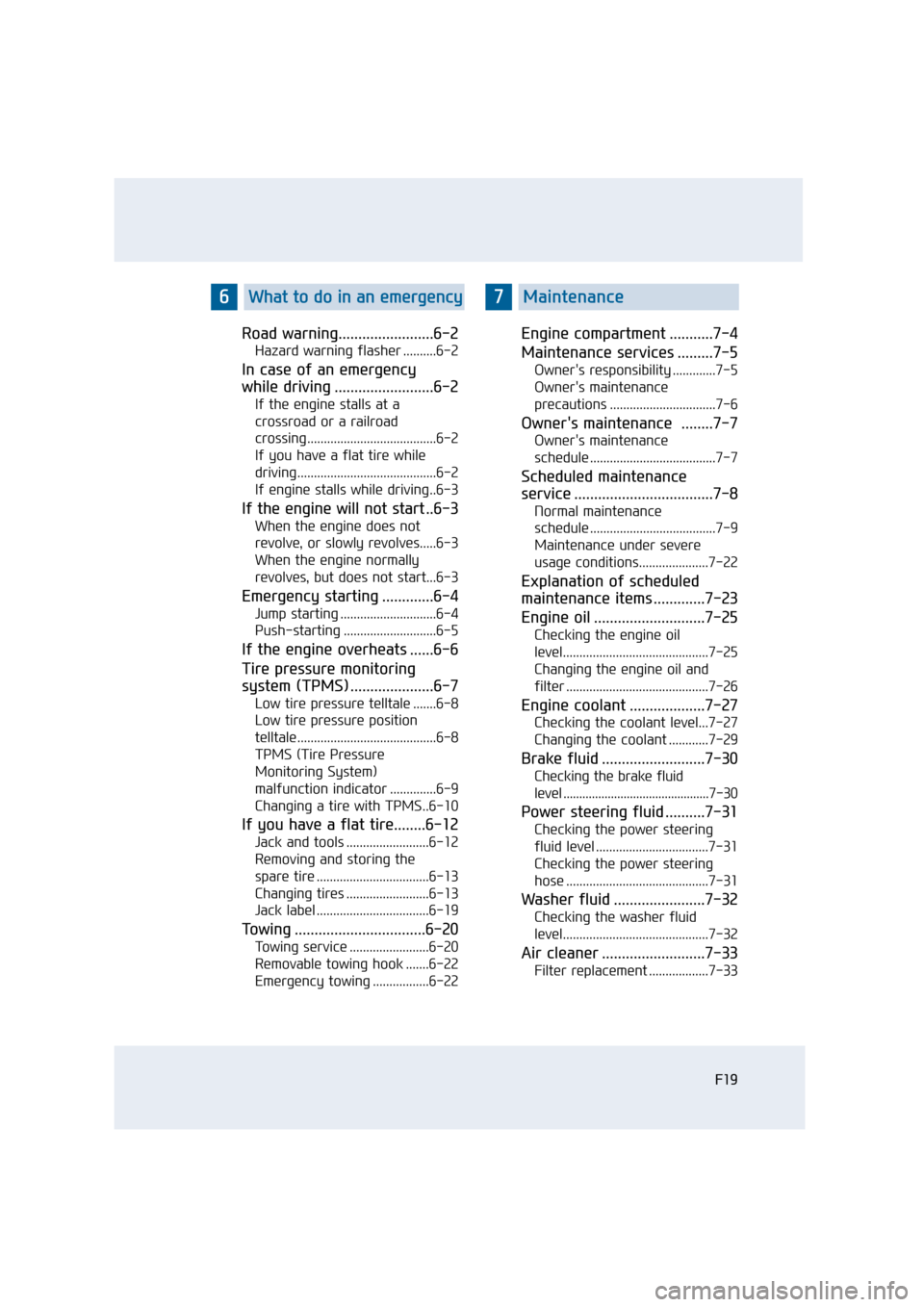
Road warning........................6-2
Hazard warning flasher ..........6-2
In case of an emergency
while driving .........................6-2
If the engine stalls at a
crossroad or a railroad
crossing.......................................6-2
If you have a flat tire while
driving..........................................6-2
If engine stalls while driving..6-3
If the engine will not start ..6-3
When the engine does not
revolve, or slowly revolves.....6-3
When the engine normally
revolves, but does not start...6-3
Emergency starting .............6-4
Jump starting .............................6-4
Push-starting ............................6-5
If the engine overheats ......6-6
Tire pressure monitoring
system (TPMS) .....................6-7
Low tire pressure telltale .......6-8
Low tire pressure position
telltale..........................................6-8
TPMS (Tire Pressure
Monitoring System)
malfunction indicator ..............6-9
Changing a tire with TPMS..6-10
If you have a flat tire........6-12
Jack and tools .........................6-12
Removing and storing the
spare tire ..................................6-13
Changing tires .........................6-13
Jack label ..................................6-19
Towing .................................6-20
Towing service ........................6-20
Removable towing hook .......6-22
Emergency towing .................6-22
Engine compartment ...........7-4
Maintenance services .........7-5
Owner's responsibility .............7-5
Owner's maintenance
precautions ................................7-6
Owner's maintenance ........7-7
Owner's maintenance
schedule ......................................7-7
Scheduled maintenance
service ...................................7-8
Normal maintenance
schedule ......................................7-9
Maintenance under severe
usage conditions.....................7-22
Explanation of scheduled
maintenance items .............7-23
Engine oil ............................7-25
Checking the engine oil
level............................................7-25
Changing the engine oil and
filter ...........................................7-26
Engine coolant ...................7-27
Checking the coolant level...7-27
Changing the coolant ............7-29
Brake fluid ..........................7-30
Checking the brake fluid
level ..............................................7-30
Power steering fluid ..........7-31
Checking the power steering
fluid level ..................................7-31
Checking the power steering
hose ...........................................7-31
Washer fluid .......................7-32
Checking the washer fluid
level............................................7-32
Air cleaner ..........................7-33
Filter replacement ..................7-33
F19
6What to do in an emergency7Maintenance
Page 22 of 477
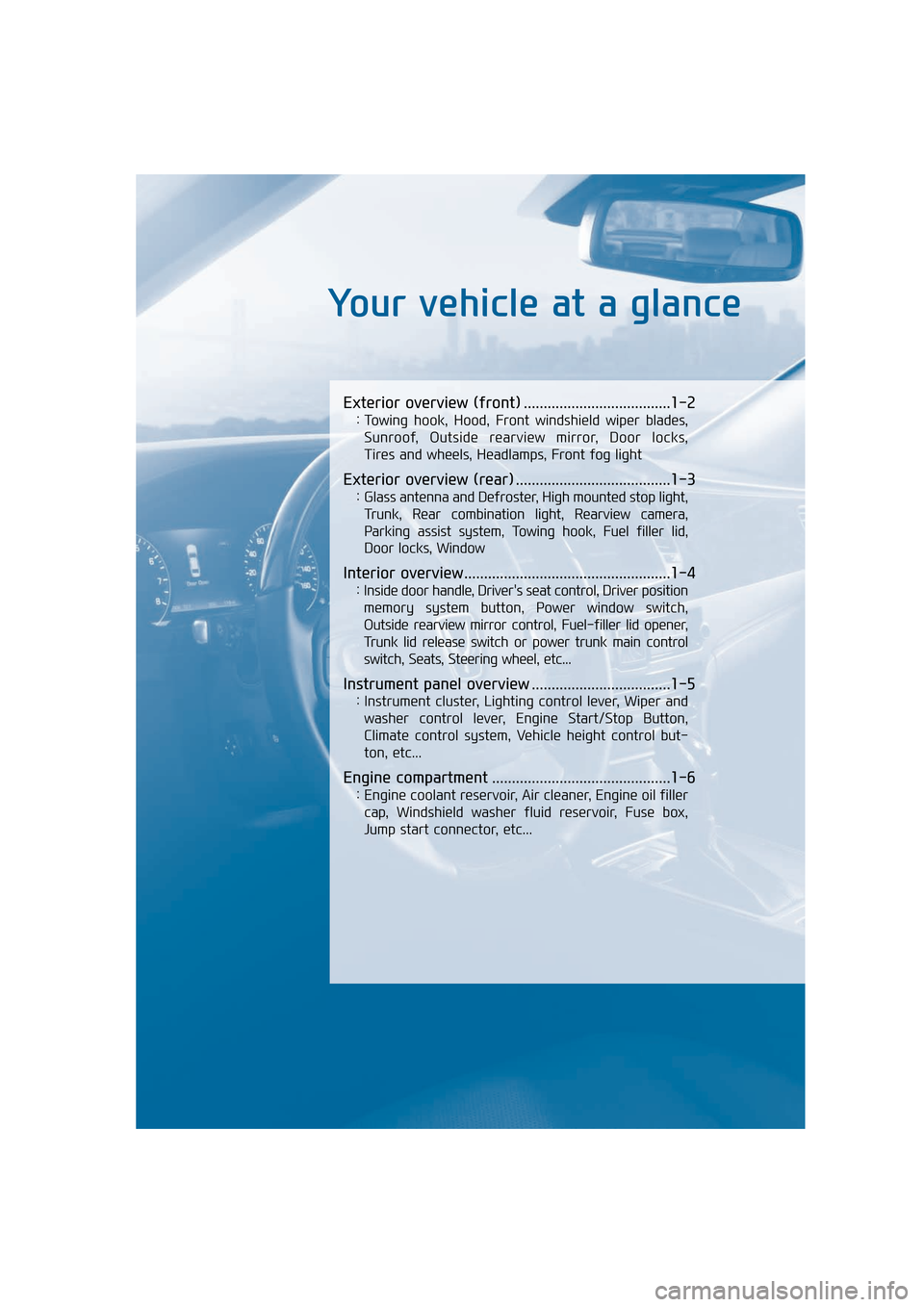
Your vehicle at a glance
Exterior overview (front) .....................................1-2
: Towing hook, Hood, Front windshield wiper blades, Sunroof, Outside rearview mirror, Door locks,
Tires and wheels, Headlamps, Front fog light
Exterior overview (rear) .......................................1-3
: Glass antenna and Defroster, High mounted stop light, Trunk, Rear combination light, Rearview camera,
Parking assist system, Towing hook, Fuel filler lid,
Door locks, Window
Interior overview ....................................................1-4
: Inside door handle, Driver's seat control, Driver position memory system button, Power window switch,
Outside rearview mirror control, Fuel-filler lid opener,
Trunk lid release switch or power trunk main control
switch, Seats, Steering wheel, etc...
Instrument panel overview ...................................1-5
: Instrument cluster, Lighting control lever, Wiper and washer control lever, Engine Start/Stop Button,
Climate control system, Vehicle height control but-
ton, etc...
Engine compartment .............................................1-6
: Engine coolant reservoir, Air cleaner, Engine oil fillercap, Windshield washer fluid reservoir, Fuse box,
Jump start connector, etc...
Page 25 of 477
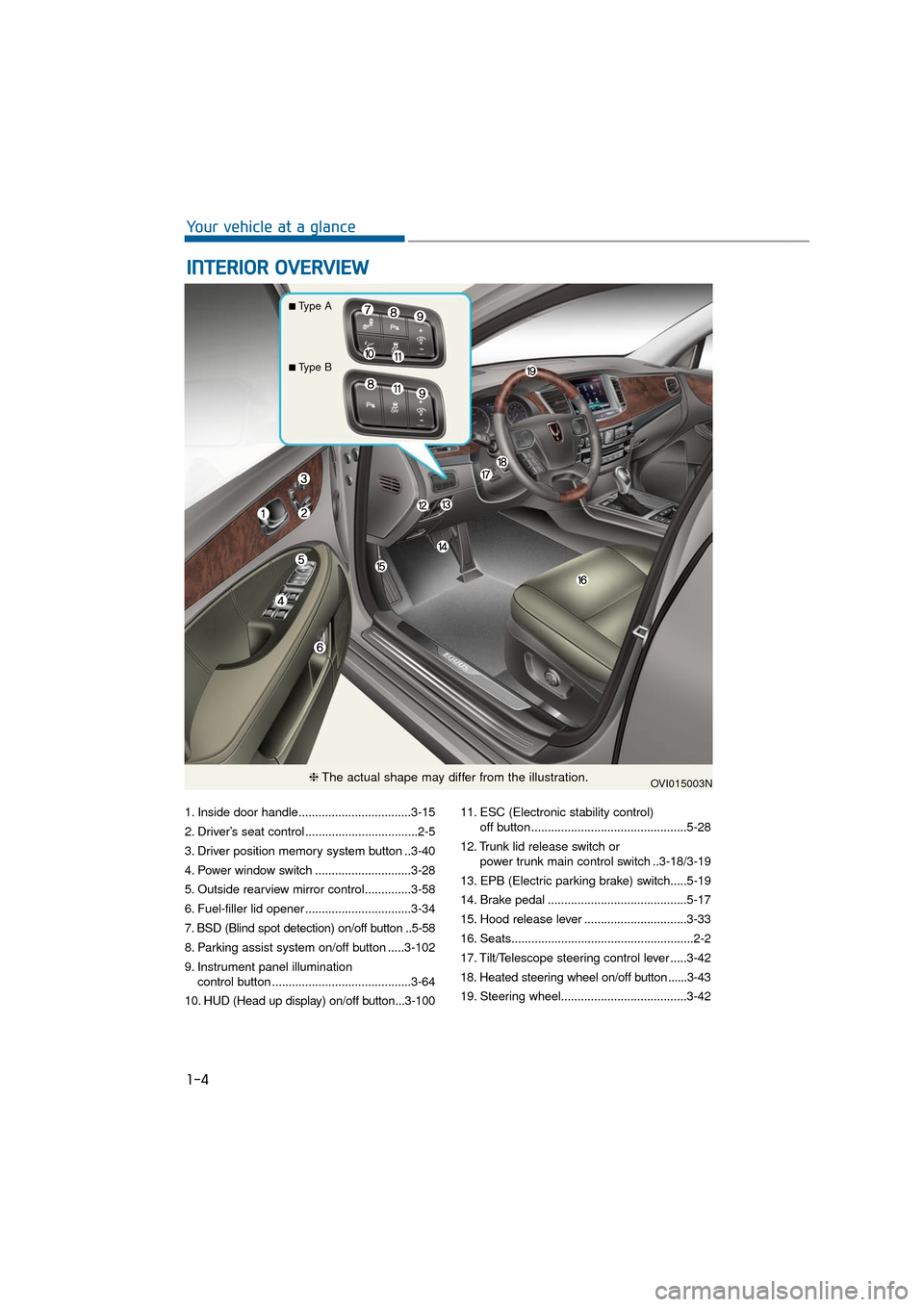
1. Inside door handle..................................3-15
2. Driver’s seat control ..................................2-5
3. Driver position memory system button ..3-40
4. Power window switch .............................3-28
5. Outside rearview mirror control..............3-58
6. Fuel-filler lid opener ................................3-34
7. BSD (Blind spot detection) on/off button ..5-58
8. Parking assist system on/off button .....3-102
9. Instrument panel illumination control button ..........................................3-64
10. HUD (Head up display) on/off button...3-100 11. ESC (Electronic stability control)
off button...............................................5-28
12. Trunk lid release switch or power trunk main control switch ..3-18/3-19
13. EPB (Electric parking brake) switch.....5-19
14. Brake pedal ..........................................5-17
15. Hood release lever ...............................3-33
16. Seats.......................................................2-2
17. Tilt/Telescope steering control lever .....3-42
18. Heated steering wheel on/off button ......3-43
19. Steering wheel......................................3-42
I I N
N T
TE
ER
R I
IO
O R
R
O
O V
VE
ER
R V
V I
IE
E W
W
1-4
Your vehicle at a glance
OVI015003N
■Type A
■Type B
❈ The actual shape may differ from the illustration.
Page 27 of 477
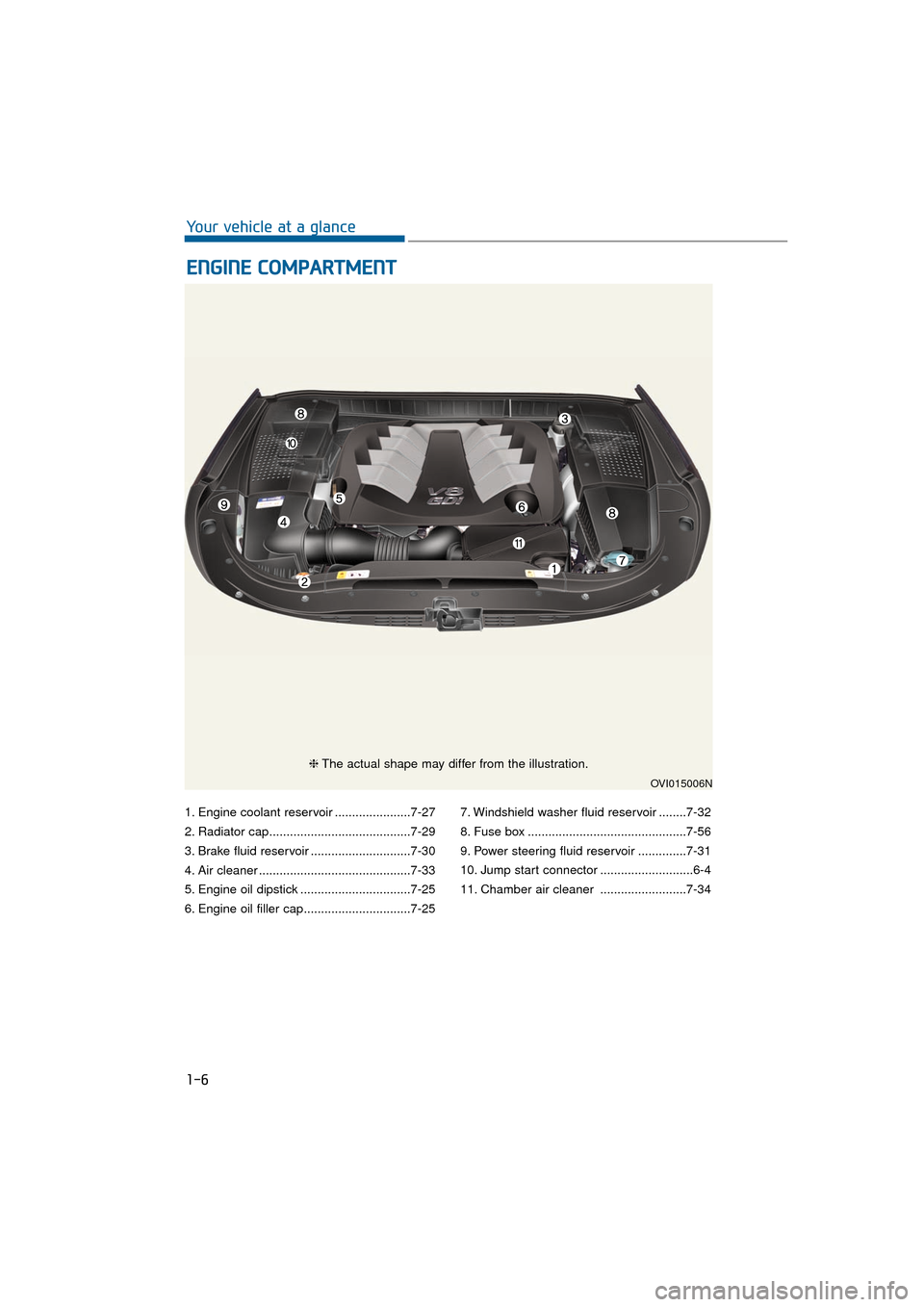
1. Engine coolant reservoir ......................7-27
2. Radiator cap.........................................7-29
3. Brake fluid reservoir .............................7-30
4. Air cleaner ............................................7-33
5. Engine oil dipstick ................................7-25
6. Engine oil filler cap...............................7-257. Windshield washer fluid reservoir ........7-32
8. Fuse box ..............................................7-56
9. Power steering fluid reservoir ..............7-31
10. Jump start connector ...........................6-4
11. Chamber air cleaner .........................7-34
E E
N
N G
GI
IN
N E
E
C
C O
O M
M P
PA
A R
RT
TM
M E
EN
N T
T
1-6
Your vehicle at a glance
OVI015006N
❈ The actual shape may differ from the illustration.
Page 30 of 477
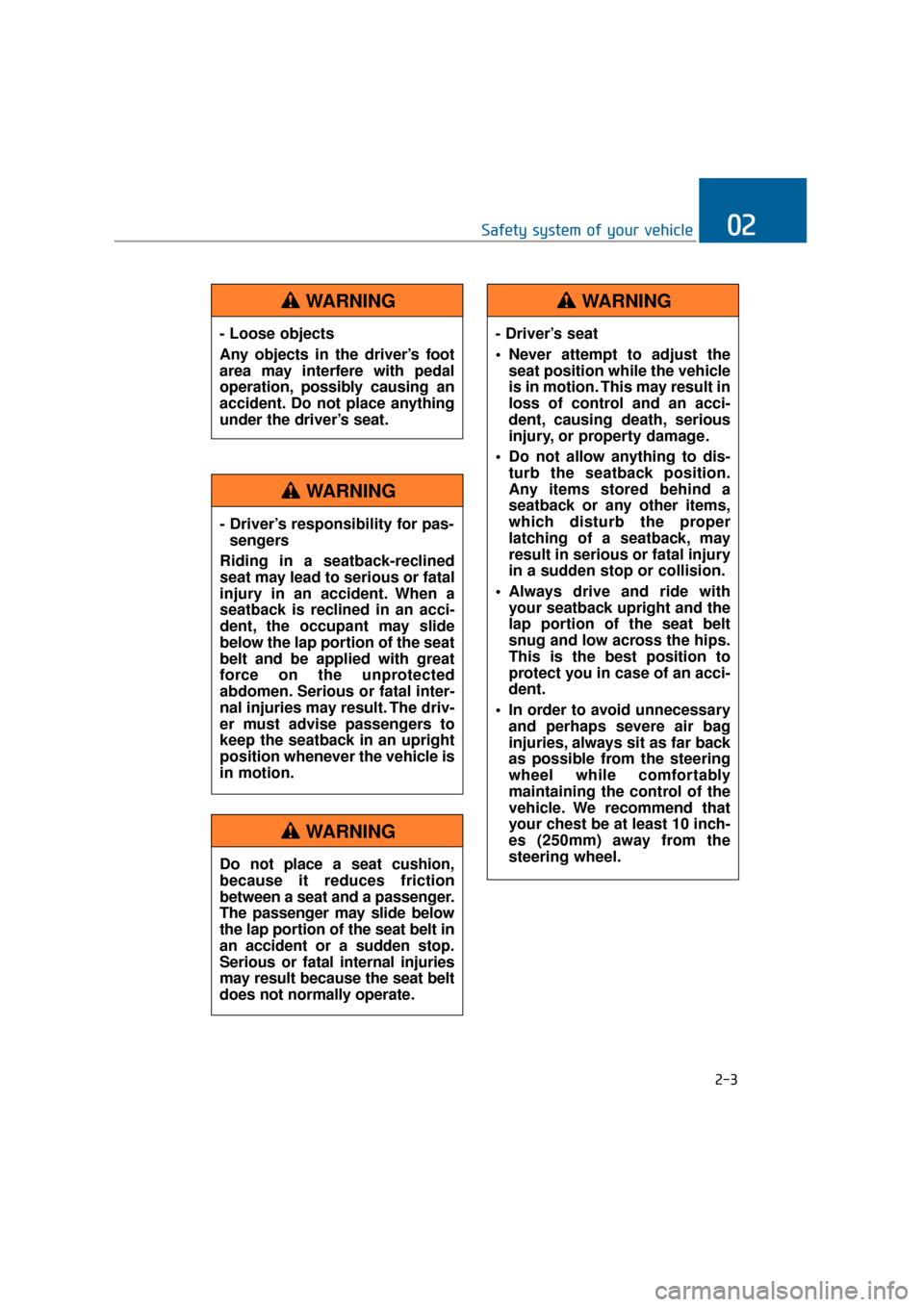
2-3
Safety system of your vehicle02
- Loose objects
Any objects in the driver’s foot
area may interfere with pedal
operation, possibly causing an
accident. Do not place anything
under the driver’s seat.
WARNING
- Driver’s responsibility for pas-sengers
Riding in a seatback-reclined
seat may lead to serious or fatal
injury in an accident. When a
seatback is reclined in an acci-
dent, the occupant may slide
below the lap portion of the seat
belt and be applied with great
force on the unprotected
abdomen. Serious or fatal inter-
nal injuries may result. The driv-
er must advise passengers to
keep the seatback in an upright
position whenever the vehicle is
in motion.
WARNING
Do not place a seat cushion,
because it reduces friction
between a seat and a passenger.
The passenger may slide below
the lap portion of the seat belt in
an accident or a sudden stop.
Serious or fatal internal injuries
may result because the seat belt
does not normally operate.
WARNING
- Driver’s seat
Never attempt to adjust the seat position while the vehicle
is in motion. This may result in
loss of control and an acci-
dent, causing death, serious
injury, or property damage.
Do not allow anything to dis- turb the seatback position.
Any items stored behind a
seatback or any other items,
which disturb the proper
latching of a seatback, may
result in serious or fatal injury
in a sudden stop or collision.
Always drive and ride with your seatback upright and the
lap portion of the seat belt
snug and low across the hips.
This is the best position to
protect you in case of an acci-
dent.
In order to avoid unnecessary and perhaps severe air bag
injuries, always sit as far back
as possible from the steering
wheel while comfortably
maintaining the control of the
vehicle. We recommend that
your chest be at least 10 inch-
es (250mm) away from the
steering wheel.
WARNING
Page 31 of 477
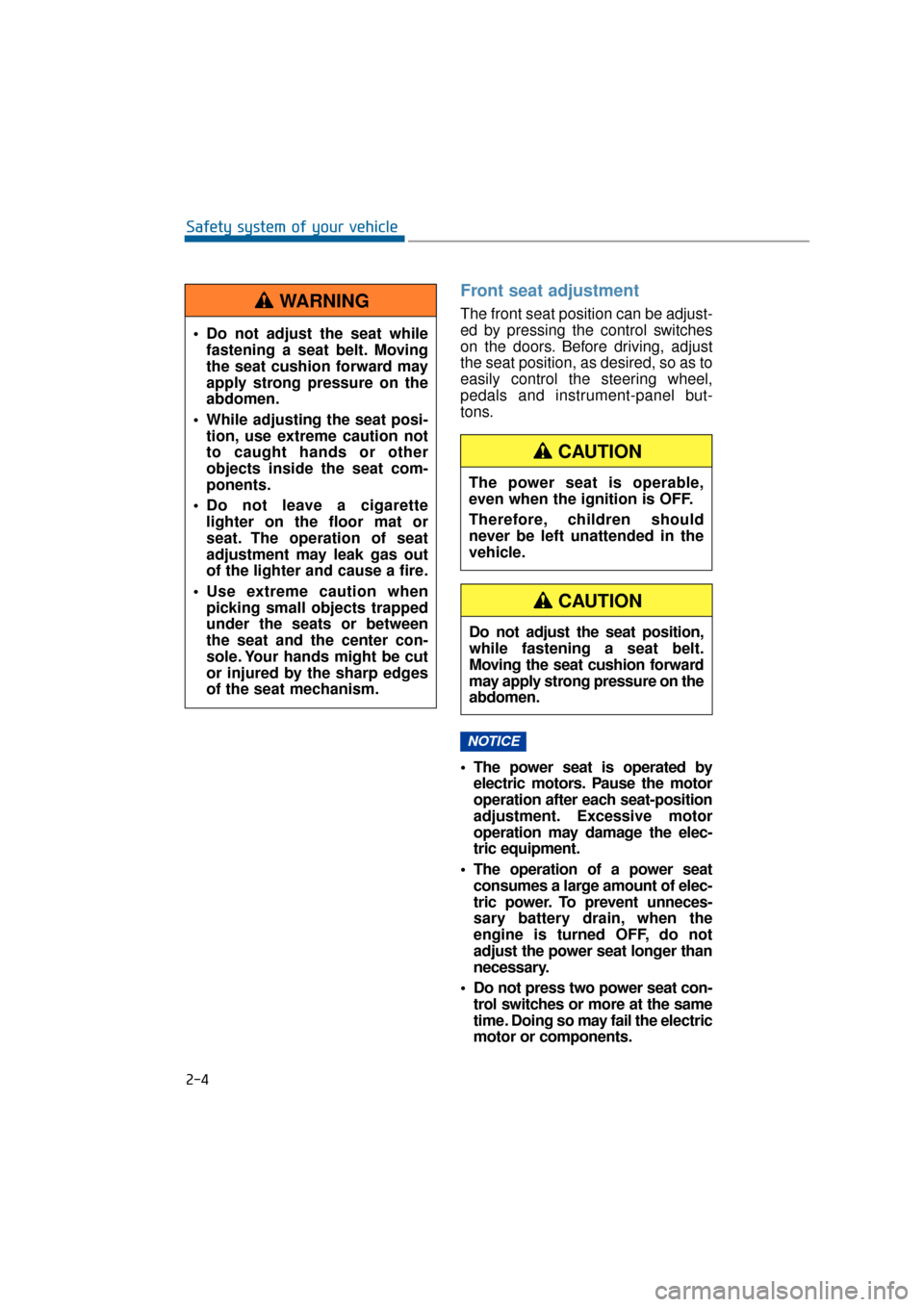
Front seat adjustment
The front seat position can be adjust-
ed by pressing the control switches
on the doors. Before driving, adjust
the seat position, as desired, so as to
easily control the steering wheel,
pedals and instrument-panel but-
tons.
The power seat is operated byelectric motors. Pause the motor
operation after each seat-position
adjustment. Excessive motor
operation may damage the elec-
tric equipment.
The operation of a power seat consumes a large amount of elec-
tric power. To prevent unneces-
sary battery drain, when the
engine is turned OFF, do not
adjust the power seat longer than
necessary.
Do not press two power seat con- trol switches or more at the same
time. Doing so may fail the electric
motor or components.
NOTICE
2-4
Safety system of your vehicle
Do not adjust the seat while fastening a seat belt. Moving
the seat cushion forward may
apply strong pressure on the
abdomen.
While adjusting the seat posi- tion, use extreme caution not
to caught hands or other
objects inside the seat com-
ponents.
Do not leave a cigarette lighter on the floor mat or
seat. The operation of seat
adjustment may leak gas out
of the lighter and cause a fire.
Use extreme caution when picking small objects trapped
under the seats or between
the seat and the center con-
sole. Your hands might be cut
or injured by the sharp edges
of the seat mechanism.
WARNING
Do not adjust the seat position,
while fastening a seat belt.
Moving the seat cushion forward
may apply strong pressure on the
abdomen.
CAUTION
The power seat is operable,
even when the ignition is OFF.
Therefore, children should
never be left unattended in the
vehicle.
CAUTION
Page 70 of 477
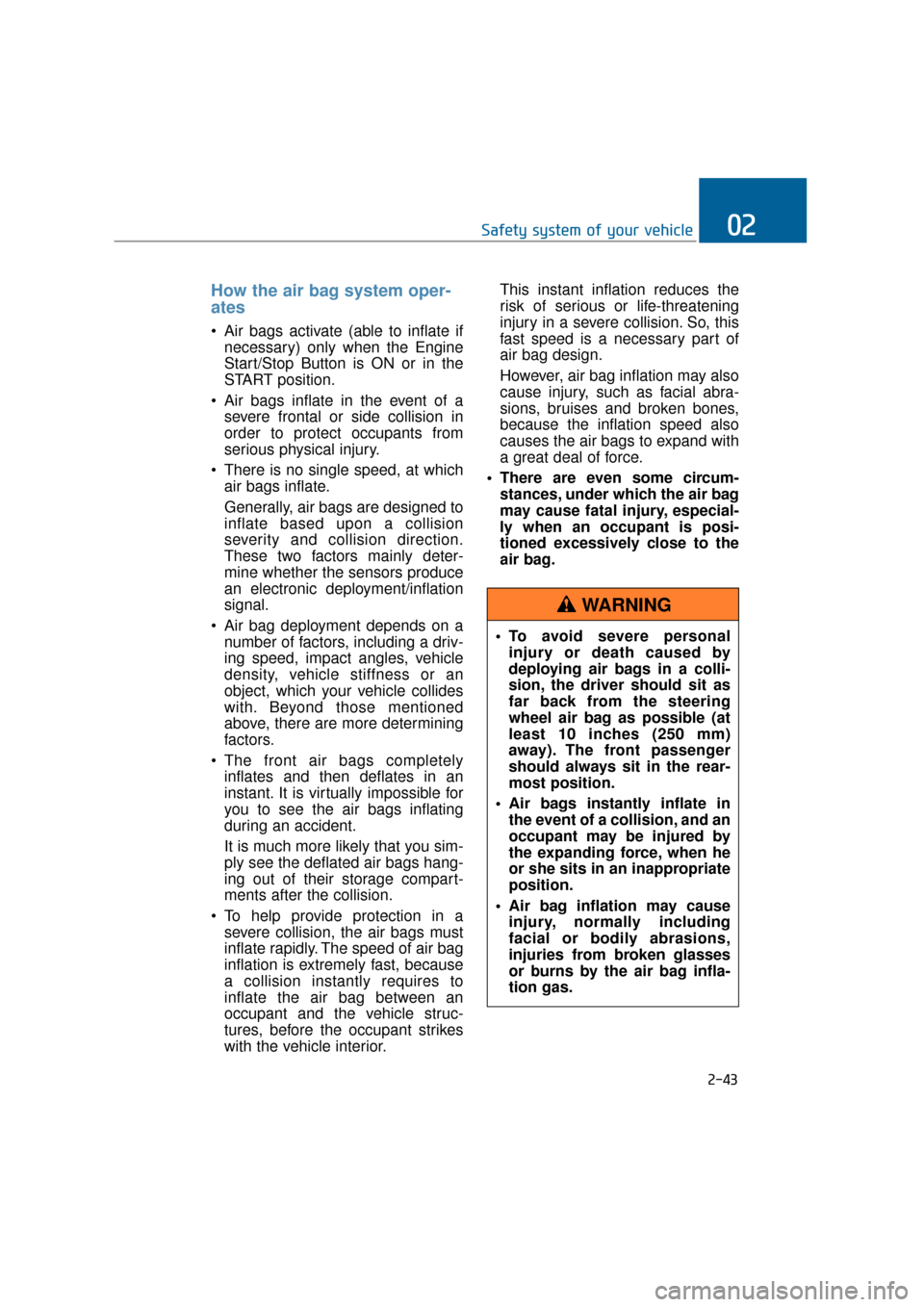
How the air bag system oper-
ates
Air bags activate (able to inflate ifnecessary) only when the Engine
Start/Stop Button is ON or in the
START position.
Air bags inflate in the event of a severe frontal or side collision in
order to protect occupants from
serious physical injury.
There is no single speed, at which air bags inflate.
Generally, air bags are designed to
inflate based upon a collision
severity and collision direction.
These two factors mainly deter-
mine whether the sensors produce
an electronic deployment/inflation
signal.
Air bag deployment depends on a number of factors, including a driv-
ing speed, impact angles, vehicle
density, vehicle stiffness or an
object, which your vehicle collides
with. Beyond those mentioned
above, there are more determining
factors.
The front air bags completely inflates and then deflates in an
instant. It is virtually impossible for
you to see the air bags inflating
during an accident.
It is much more likely that you sim-
ply see the deflated air bags hang-
ing out of their storage compart-
ments after the collision.
To help provide protection in a severe collision, the air bags must
inflate rapidly. The speed of air bag
inflation is extremely fast, because
a collision instantly requires to
inflate the air bag between an
occupant and the vehicle struc-
tures, before the occupant strikes
with the vehicle interior. This instant inflation reduces the
risk of serious or life-threatening
injury in a severe collision. So, this
fast speed is a necessary part of
air bag design.
However, air bag inflation may also
cause injury, such as facial abra-
sions, bruises and broken bones,
because the inflation speed also
causes the air bags to expand with
a great deal of force.
There are even some circum- stances, under which the air bag
may cause fatal injury, especial-
ly when an occupant is posi-
tioned excessively close to the
air bag.
2-43
Safety system of your vehicle02
To avoid severe personalinjury or death caused by
deploying air bags in a colli-
sion, the driver should sit as
far back from the steering
wheel air bag as possible (at
least 10 inches (250 mm)
away). The front passenger
should always sit in the rear-
most position.
Air bags instantly inflate in the event of a collision, and an
occupant may be injured by
the expanding force, when he
or she sits in an inappropriate
position.
Air bag inflation may cause injury, normally including
facial or bodily abrasions,
injuries from broken glasses
or burns by the air bag infla-
tion gas.
WARNING
Page 71 of 477
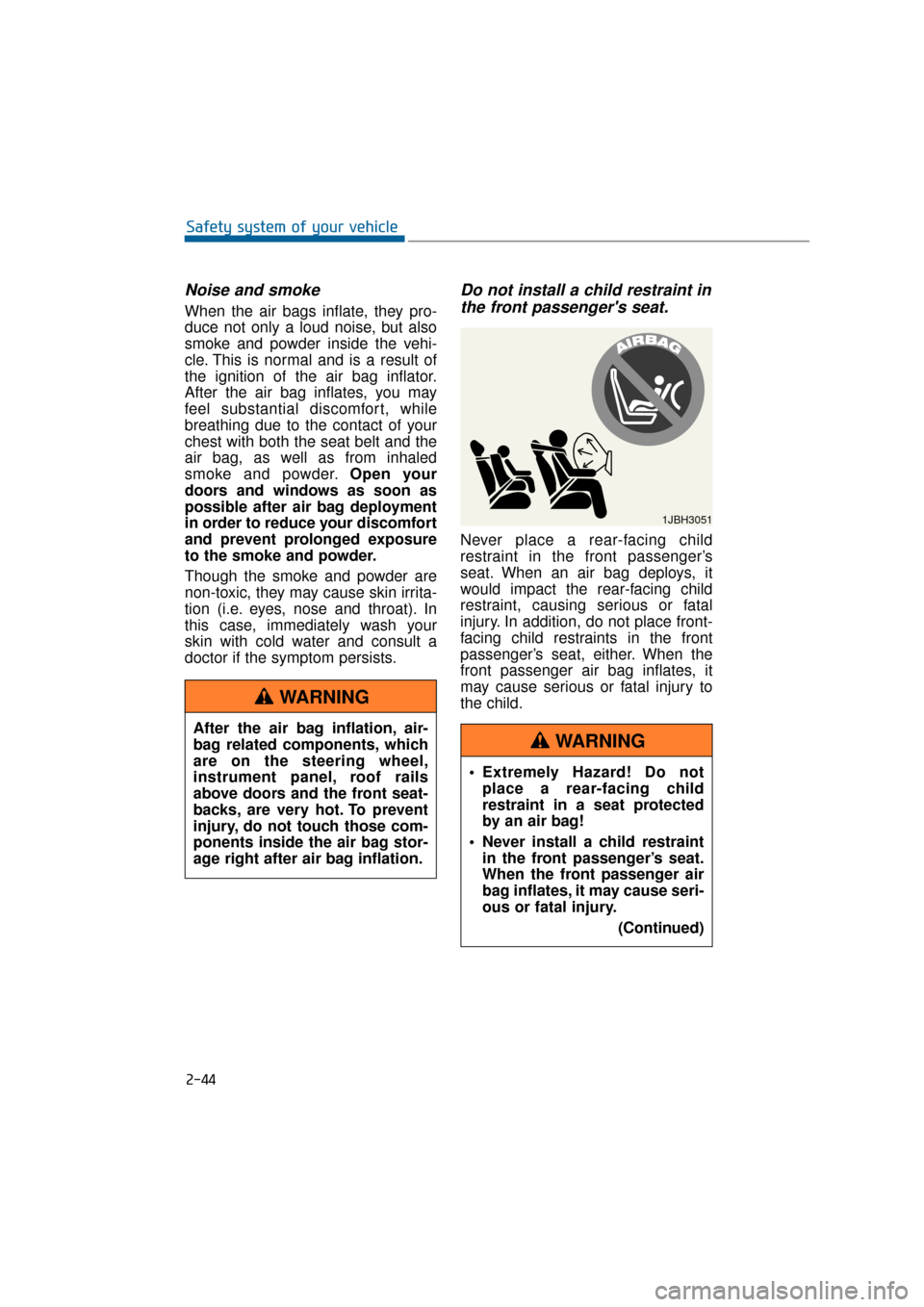
Noise and smoke
When the air bags inflate, they pro-
duce not only a loud noise, but also
smoke and powder inside the vehi-
cle. This is normal and is a result of
the ignition of the air bag inflator.
After the air bag inflates, you may
feel substantial discomfort, while
breathing due to the contact of your
chest with both the seat belt and the
air bag, as well as from inhaled
smoke and powder.Open your
doors and windows as soon as
possible after air bag deployment
in order to reduce your discomfort
and prevent prolonged exposure
to the smoke and powder.
Though the smoke and powder are
non-toxic, they may cause skin irrita-
tion (i.e. eyes, nose and throat). In
this case, immediately wash your
skin with cold water and consult a
doctor if the symptom persists.
Do not install a child restraint in the front passenger's seat.
Never place a rear-facing child
restraint in the front passenger’s
seat. When an air bag deploys, it
would impact the rear-facing child
restraint, causing serious or fatal
injury. In addition, do not place front-
facing child restraints in the front
passenger’s seat, either. When the
front passenger air bag inflates, it
may cause serious or fatal injury to
the child.
2-44
Safety system of your vehicle
After the air bag inflation, air-
bag related components, which
are on the steering wheel,
instrument panel, roof rails
above doors and the front seat-
backs, are very hot. To prevent
injury, do not touch those com-
ponents inside the air bag stor-
age right after air bag inflation.
WARNING
1JBH3051
Extremely Hazard! Do not place a rear-facing child
restraint in a seat protected
by an air bag!
Never install a child restraint in the front passenger’s seat.
When the front passenger air
bag inflates, it may cause seri-
ous or fatal injury.
(Continued)
WARNING